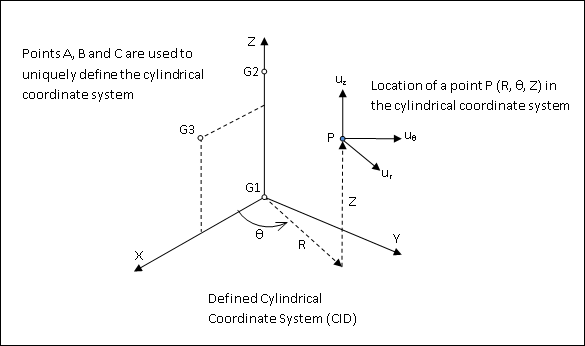CORD1C |

|

|

|

|
|
CORD1C |

|

|

|

|
Bulk Data Entry
CORD1C – Cylindrical Coordinate System Definition, Form 1
Description
This entry defines a cylindrical coordinate system using three grid points. The first point is the origin, the second lies on the Z-axis, and the third lies in the X-Z plane (see Figure 1).
Format
(1) |
(2) |
(3) |
(4) |
(5) |
(6) |
(7) |
(8) |
(9) |
(10) |
CORD1C |
CID |
G1 |
G2 |
G3 |
CID |
G1 |
G2 |
G3 |
|
|
Field |
Contents |
CID |
Unique coordinate system identification number. (Integer > 0) |
G1, G2, G3 |
Grid point identification numbers of points used to uniquely define the cylindrical coordinate system (see Figure 1). (Integer > 0; G1 ≠ G2 ≠ G3) |

Figure 1: Defining a Cylindrical Coordinate System (CID) using grid points G1, G2 and G3.
| 1. | Coordinate system identification numbers (CID) on all CORD1C, CORD1R, CORD1S, CORD2C, CORD2R, CORD2S, CORD3R, and CORD4R entries must all be unique. |
| 2. | A duplicate identification number is allowed if the CID and GID are identical and the coordinates are within the value set by PARAM, DUPTOL (see Guidelines for Bulk Data Entries for further information). |
| 3. | The three points G1, G2, G3 must be non-collinear. Non-collinearity is checked by the geometry processor. |
| 4. | The location of a grid point (P in Figure 1) in this cylindrical coordinate system is given by (R, θ, and Z) where, θ is measured in degrees. |
| 5. | The displacement coordinate directions at P are dependent on the location of P (ur, uθ, and uz) as shown in Figure 1. The displacements in all three of these directions at the grid point are specified in units of length. |
In OptiStruct, the cylindrical and spherical coordinate systems are internally resolved to entity-position-dependent (example: GRID) rectangular systems. Therefore, when a grid point is located in a cylindrical system, OptiStruct constructs a rectangular system at that location for the grid point. The R-direction corresponds to the X-axis, the Z-axis is the same, and the θ axis is tangential to the X (or R) axis. Now the various degrees-of-freedom can be resolved (vis-à-vis constraints) similar to a general rectangular system. Care must be taken to observe that the internally generated rectangular systems are dependent on the grid point location in the cylindrical system. So they may be different for different grid point locations within the same cylindrical system.
| 6. | Points on the Z-axis should not have their displacement directions defined in this coordinate system due to ambiguity. In this case, the defining rectangular system is used. |
| 7. | A maximum of two coordinate systems may be defined on a single entry. |
| 8. | This card is represented as a system in HyperMesh. |
See Also: